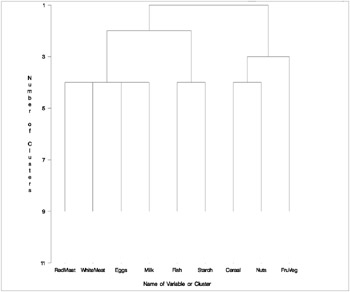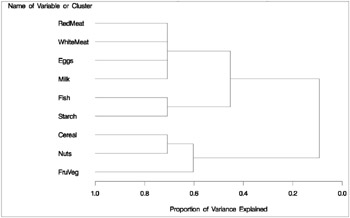Getting Started
The TREE procedure creates tree diagrams from a SAS data set containing the tree structure. You can create this type of data set with the CLUSTER or VARCLUS procedure.
In the following example, the VARCLUS procedure is used to divide a set of variables into hierarchical clusters and to create the SAS data set containing the tree structure. The TREE procedure then generates the tree diagrams.
The following data, from Hand, et al. (1994), represent the amount of protein consumed from nine food groups for each of 25 European countries . The nine food groups are red meat ( RedMeat ), white meat ( WhiteMeat ), eggs ( Eggs ), milk ( Milk ), fish ( Fish ), cereal ( Cereal ), starch ( Starch ), nuts ( Nuts ), and fruits and vegetables ( FruVeg ).
The following SAS statements create the data set Protein :
data Protein; input Country . RedMeat WhiteMeat Eggs Milk Fish Cereal Starch Nuts FruVeg; datalines; Albania 10.1 1.4 0.5 8.9 0.2 42.3 0.6 5.5 1.7 Austria 8.9 14.0 4.3 19.9 2.1 28.0 3.6 1.3 4.3 Belgium 13.5 9.3 4.1 17.5 4.5 26.6 5.7 2.1 4.0 Bulgaria 7.8 6.0 1.6 8.3 1.2 56.7 1.1 3.7 4.2 Czechoslovakia 9.7 11.4 2.8 12.5 2.0 34.3 5.0 1.1 4.0 Denmark 10.6 10.8 3.7 25.0 9.9 21.9 4.8 0.7 2.4 E Germany 8.4 11.6 3.7 11.1 5.4 24.6 6.5 0.8 3.6 Finland 9.5 4.9 2.7 33.7 5.8 26.3 5.1 1.0 1.4 France 18.0 9.9 3.3 19.5 5.7 28.1 4.8 2.4 6.5 Greece 10.2 3.0 2.8 17.6 5.9 41.7 2.2 7.8 6.5 Hungary 5.3 12.4 2.9 9.7 0.3 40.1 4.0 5.4 4.2 Ireland 13.9 10.0 4.7 25.8 2.2 24.0 6.2 1.6 2.9 Italy 9.0 5.1 2.9 13.7 3.4 36.8 2.1 4.3 6.7 Netherlands 9.5 13.6 3.6 23.4 2.5 22.4 4.2 1.8 3.7 Norway 9.4 4.7 2.7 23.3 9.7 23.0 4.6 1.6 2.7 Poland 6.9 10.2 2.7 19.3 3.0 36.1 5.9 2.0 6.6 Portugal 6.2 3.7 1.1 4.9 14.2 27.0 5.9 4.7 7.9 Romania 6.2 6.3 1.5 11.1 1.0 49.6 3.1 5.3 2.8 Spain 7.1 3.4 3.1 8.6 7.0 29.2 5.7 5.9 7.2 Sweden 9.9 7.8 3.5 4.7 7.5 19.5 3.7 1.4 2.0 Switzerland 13.1 10.1 3.1 23.8 2.3 25.6 2.8 2.4 4.9 UK 17.4 5.7 4.7 20.6 4.3 24.3 4.7 3.4 3.3 USSR 9.3 4.6 2.1 16.6 3.0 43.6 6.4 3.4 2.9 W Germany 11.4 12.5 4.1 18.8 3.4 18.6 5.2 1.5 3.8 Yugoslavia 4.4 5.0 1.2 9.5 0.6 55.9 3.0 5.7 3.2 ; run;
The data set Protein contains the character variable Country and the nine numeric variables representing the food groups. The $15. in the INPUT statement specifies that the variable Country is a character variable with a length of 15.
The following statements cluster the variables in the data set Protein .The OUTTREE= option creates an output SAS data set named Tree to contain the tree structure. The CENTROID option specifies the centroid clustering method, and the MAXCLUSTERS= option specifies that the largest number of clusters desired is four. The NOPRINT option suppresses the display of the output. The VAR statement specifies that all numeric variables ( RedMeat - FruVeg ) are used by the procedure.
proc varclus data=Protein outtree=Tree centroid maxclusters=4 noprint; var RedMeat--FruVeg; run;
The output data set Tree , created by the OUTTREE= option in the previous statements, contains the following variables:
| _NAME_ | the name of the cluster |
| _PARENT_ | the parent of the cluster |
| _NCL_ | the number of clusters |
| _VAREXP_ | the amount of variance explained by the cluster |
| _PROPOR_ | the proportion of variance explained by the clusters at the current level of the tree diagram |
| _MINPRO_ | the minimum proportion of variance explained by a cluster |
| _MAXEIGEN_ | the maximum second eigenvalue of a cluster |
The following statements produce a tree diagram of the clusters created by PROC VARCLUS:
proc tree data=tree ; proc tree data=tree lineprinter;
PROC TREE is invoked twice. In the first invocation, the tree diagram is presented using the default high resolution graphical output. In the second invocation, the LINEPRINTER option specifies line printer output.
Figure 76.1 displays the default high resolution graphics version of the tree diagram.

Figure 76.1: High Resolution Tree Diagram from PROC TREE
Figure 76.2 displays the same information as Figure 76.1, using line printer output.
| |
Oblique Centroid Component Clustering Name of Variable or Cluster W h R i e t S C F d e t e r M M E M F a r N u e e g i i r e u V a a g l s c a t e t t s k h h l s g 1 +XXXXXXXXXXXXXXXXXXXXXXXXXXXXXXXXXXXXXXXXXXXXXXXXX XXXXXXXXXXXXXXXXXXXXXXXXXXXXXXX XXXXXXXXXXXXX XXXXXXXXXXXXXXXXXXXXXXXXXXXXXXX XXXXXXXXXXXXX N 2 +XXXXXXXXXXXXXXXXXXXXXXXXXXXXXXX XXXXXXXXXXXXX u XXXXXXXXXXXXXXXXXXX XXXXXXX XXXXXXXXXXXXX m XXXXXXXXXXXXXXXXXXX XXXXXXX XXXXXXXXXXXXX b 3 +XXXXXXXXXXXXXXXXXXX XXXXXXX XXXXXXXXXXXXX e XXXXXXXXXXXXXXXXXXX XXXXXXX XXXXXXX . r XXXXXXXXXXXXXXXXXXX XXXXXXX XXXXXXX . 4 +XXXXXXXXXXXXXXXXXXX XXXXXXX XXXXXXX . o . . . . . . . . . f . . . . . . . . . 5 +. . . . . . . . . C . . . . . . . . . l . . . . . . . . . u 6 +. . . . . . . . . s . . . . . . . . . t . . . . . . . . . e 7 +. . . . . . . . . r . . . . . . . . . s . . . . . . . . . 8 +. . . . . . . . . . . . . . . . . . . . . . . . . . . 9 +. . . . . . . . .
| |
Figure 76.2: Line Printer Graphics Version of the Tree Diagram
In both figures, the name of the cluster is displayed on the horizontal axis and the number of clusters is displayed on the vertical or height axis.
As you look up from the bottom of the figures, clusters are progressively joined until a single, all-encompassing cluster is formed at the top (or root) of the diagram. Clusters exist at each level of the diagram. For example, at the level where the diagram indicates three clusters, the clusters are as follows :
-
Cluster 1: RedMeat WhiteMeat Eggs Milk
-
Cluster 2: Fish Starch
-
Cluster 3: Cereal Nuts FruVeg
As you proceed up the diagram one level, the number of clusters is two. The clusters are
-
Cluster 1: RedMeat WhiteMeat Eggs Milk Fish Starch
-
Cluster 2: Cereal Nuts FruVeg
The following statements illustrate how you can specify the numeric variable defining the height of each node (cluster) in the tree. First, the AXIS1 statement is defined. The ORDER= option specifies the data values in the order in which they are to appear on the axis.
Next , the TREE procedure is invoked. The HORIZONTAL option orients the tree diagram horizontally. The HAXIS option specifies that the AXIS1 statement be used to customize the appearance of the horizontal axis. The HEIGHT statement specifies the variable _PROPOR_ (the proportion of variance explained) as the height variable.
axis1 order=(0 to 1 by 0.2); proc tree data=Tree horizontal haxis=axis1; height _PROPOR_; run;
Figure 76.3 displays the tree diagram oriented horizontally, using the variable _PROPOR_ as the height variable. As you look from left to right in the diagram, objects and clusters are progressively joined until a single, all-encompassing cluster is formed at the right (or root) of the diagram.

Figure 76.3: Horizontal Tree Diagram Using _PROPOR_ as the HEIGHT Variable
Clusters exist at each level of the diagram, represented by horizontal line segments. Each vertical line segment represents a point where leaves and branches are connected into progressively larger clusters.
For example, three clusters are formed at the left-most point along the axis where three horizontal line segments exist. At that point, where a vertical line segment connects the Cereal-Nuts and FruVeg clusters, the proportion of variance explained is about 0.6 ( _PROPOR_ = 0.6). At the next clustering level the variables Fish and Starch are clustered with variables RedMeat through Milk , resulting in a total of two clusters. The proportion of variance explained is about 0.45 at that point.
EAN: 2147483647
Pages: 132
- Chapter I e-Search: A Conceptual Framework of Online Consumer Behavior
- Chapter II Information Search on the Internet: A Causal Model
- Chapter IV How Consumers Think About Interactive Aspects of Web Advertising
- Chapter X Converting Browsers to Buyers: Key Considerations in Designing Business-to-Consumer Web Sites
- Chapter XIII Shopping Agent Web Sites: A Comparative Shopping Environment